 | –≠–Ľ–Ķ–ļ—ā—Ä–ĺ–Ĺ–Ĺ—č–Ļ –ļ–ĺ–ľ–Ņ–ĺ–Ĺ–Ķ–Ĺ—ā: UC3173A | –°–ļ–į—á–į—ā—Ć:  PDF PDF  ZIP ZIP |
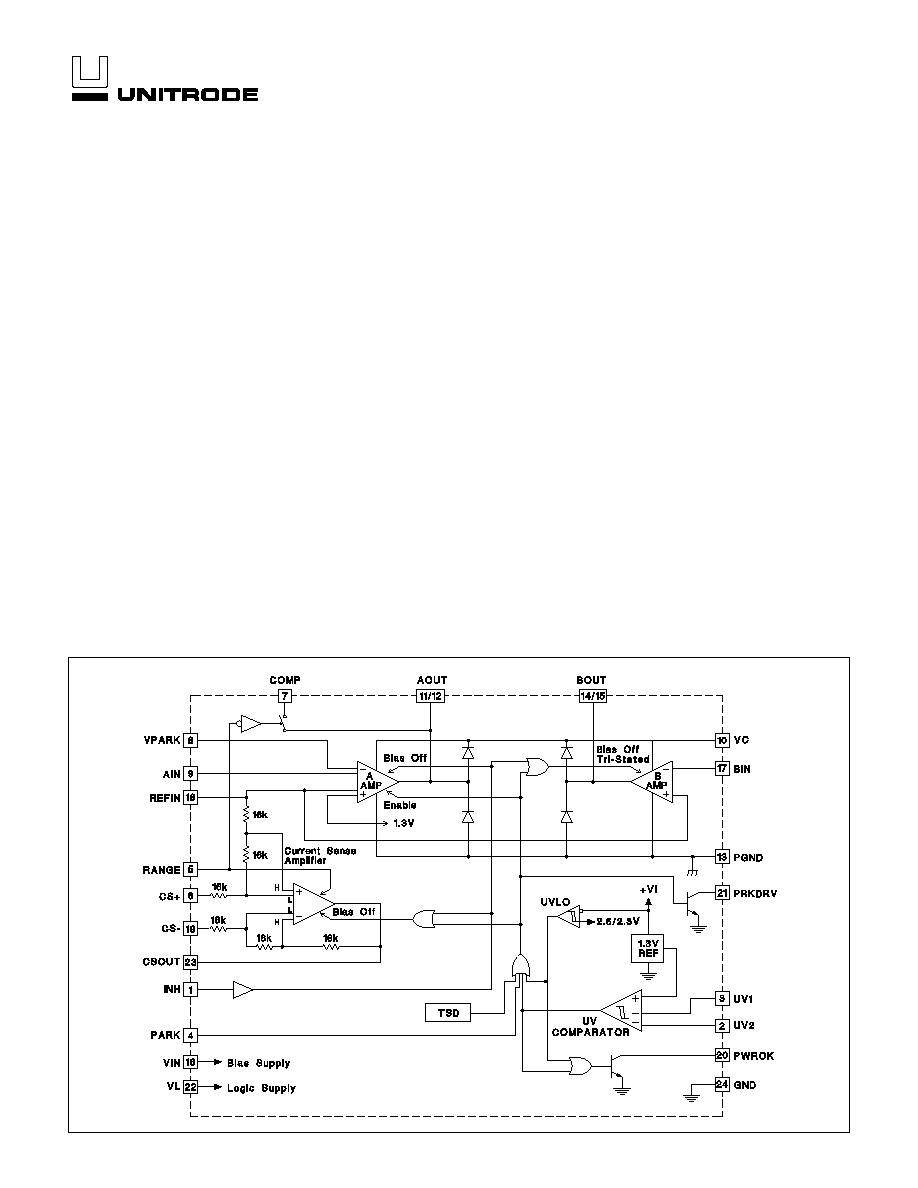
UC3173A
Full Bridge Power Amplifier
FEATURES
∑
Precision Current Control
∑ Ī
500mA Load Current
∑
1.3V Typical Total V
SAT
at 550mA
∑
Controlled Velocity Head Parking
∑
Precision Dual Supply Monitor with
Indicator
∑
Range Control for 4:1 Gain Change
∑
Compensation Adjust Pin for
Bandwidth Control
∑
Inhibit Input and UVLO
∑
5V or 12V Operation
∑
12mA Quiescent Supply Current
∑
PLCC, SOIC, and Low Profile Quad
Flat Pack Packages
DESCRIPTION
This full bridge power amplifier, rated for continuous output current of
0.55A, is intended for use in demanding servo applications such as head
positioning for high density disk drives. This device includes a precision cur-
rent sense amplifier that senses load current with a single resistor in series
with the load. The UC3173A is optimized to consume a minimum of supply
current, and is designed to operate in both 5V and 12V systems. The power
output stages have a low saturation voltage and are protected with current
limiting and thermal shutdown. When inhibited the device will draw less
than 1.5mA of total supply current.
Auxiliary functions on this device include a dual input undervoltage com-
parator, which can monitor two independent supply voltages and activate
the built in head park function when either is below minimum. The park cir-
cuitry allows a programmable retract voltage to be applied to the load for
limiting maximum head velocity. A separate low side parking drive pin per-
mits a series impedance to be inserted to control maximum retract current.
The parking drive function can be configured to operate with supply volt-
ages as low as 1.2V.
The closed loop transconductance of the configured power amplifier can be
switched between a high and low range with a logic input. The 4:1 change
in gain can be used to extend the dynamic range of the servo loop. Band-
width variations that would otherwise result with the gain change can be
controlled with a compensation adjust pin.
BLOCK DIAGRAM
04/99
UDG-94039

2
UC3173A
Input Supply Voltage, (VIN, VC, VL) . . . . . . . . . . . . . . . . . . 20V
UV Comparator
Maximum Forced Voltage . . . . . . . . . . . . . . . .
-
0.3V to 10V
Maximum Forced Current . . . . . . . . . . . . . . . . . . . . .
Ī
10mA
B Amplifier Inverting Input . . . . . . . . . . . . . .
-
0.3V to VIN + 1.0
A Amplifier Inverting Inputs,
(Aux. and Normal) . . . . . . . . . . . . . . . . .
-
0.3V to VC + 1.0V
Open Collector Output Voltages . . . . . . . . . . . . . . . . . . . . . 20V
A and B Output Currents (Continuous)
Source . . . . . . . . . . . . . . . . . . . . . . . . . . . . Internally Limited
Sink . . . . . . . . . . . . . . . . . . . . . . . . . . . . . . . . . . . . . . . . 0.6A
Parking Drive Output Current
Continuous . . . . . . . . . . . . . . . . . . . . . . . . . . . . . . . . 150mA
Pulsed. . . . . . . . . . . . . . . . . . . . . . . . . . . . . . . . . . . . . . . . 1A
Output Diode Current (Pulsed) . . . . . . . . . . . . . . . . . . . . . . 0.6A
Power OK Output Current (Continuous) . . . . . . . . . . . . . . 30mA
Operating Junction Temperature . . . . . . . . . .
-
55įC to +150įC
Storage Temperature . . . . . . . . . . . . . . . . . . .
-
65
į
C to +150
į
C
Lead Temperature . . . . . . . . . . . . . . . . . . . . . . . . . . . . . +300
į
C
Note 1: Unless otherwise indicated, voltages are referenced to
ground and currents are positive into, negative out of, the speci-
fied terminals, "Pulsed" is defined as a less than 10% duty cycle
pulse with a maximum duration of 500
Ķ
s.
ABSOLUTE MAXIMUM RATINGS (Note 1)
DW Package:
Thermal Resistance Junction to Leads,
jl . . . . . . . . 35
į
C/W
Thermal Resistance Junction to Ambient,
ja . . . . 60-70
į
C/W
FQ Package:
Thermal Resistance Junction to Leads,
jl . . . . . . . . . 60
į
C/W
Thermal Resistance Junction to Ambient,
ja . . 110-120
į
C/W
QP Package:
Thermal Resistance Junction to Leads,
jl . . . . . . . . . 15
į
C/W
Thermal Resistance Junction to Ambient,
ja . . . . 30-40
į
C/W
Note 2: The above numbers for
jl are maximums for the limiting
thermal resistance of the package in a standard mounting con-
figuration. The
ja numbers are meant to be guide lines for the
thermal performance of the device/pc-board system. All of the
above numbers assume no ambient airflow.
Note 3: Consult Packaging Section of Unitrode Integrated Cir-
cuits databook for thermal specifications and limitations of pack-
ages.
THERMAL DATA
SOIC-24 (Top View)
DW Package
PLCC-28 (Top View)
QP Package
48
47
46
45
1
44
43
42
41
40
39
38
37
2
3
4
5
6
7
8
9
10
11
12
13
14
15
16
17
18
19
20
21
22
23
24
36
35
34
33
32
31
30
29
28
27
26
25
N/C
N/C
VIN
BIN
N/C
N/C
PRKDRV
PWROK
REFIN
N/C
N/C
N/C
BOUT
BOUT
N/C
N/C
N/C
AOUT
AOUT
N/C
N/C
N/C
AIN
VC
RANGE
CS+
COMP
VPARK
N/C
GND
CSOUT
VL
INH
N/C
UV1
UV2
PARK
PGND
N/C
PGND
CS≠
N/C
N/C
N/C
N/C
N/C
N/C
N/C
CONNECTION DIAGRAMS
TQFP-48 (Top View)
FQ Package
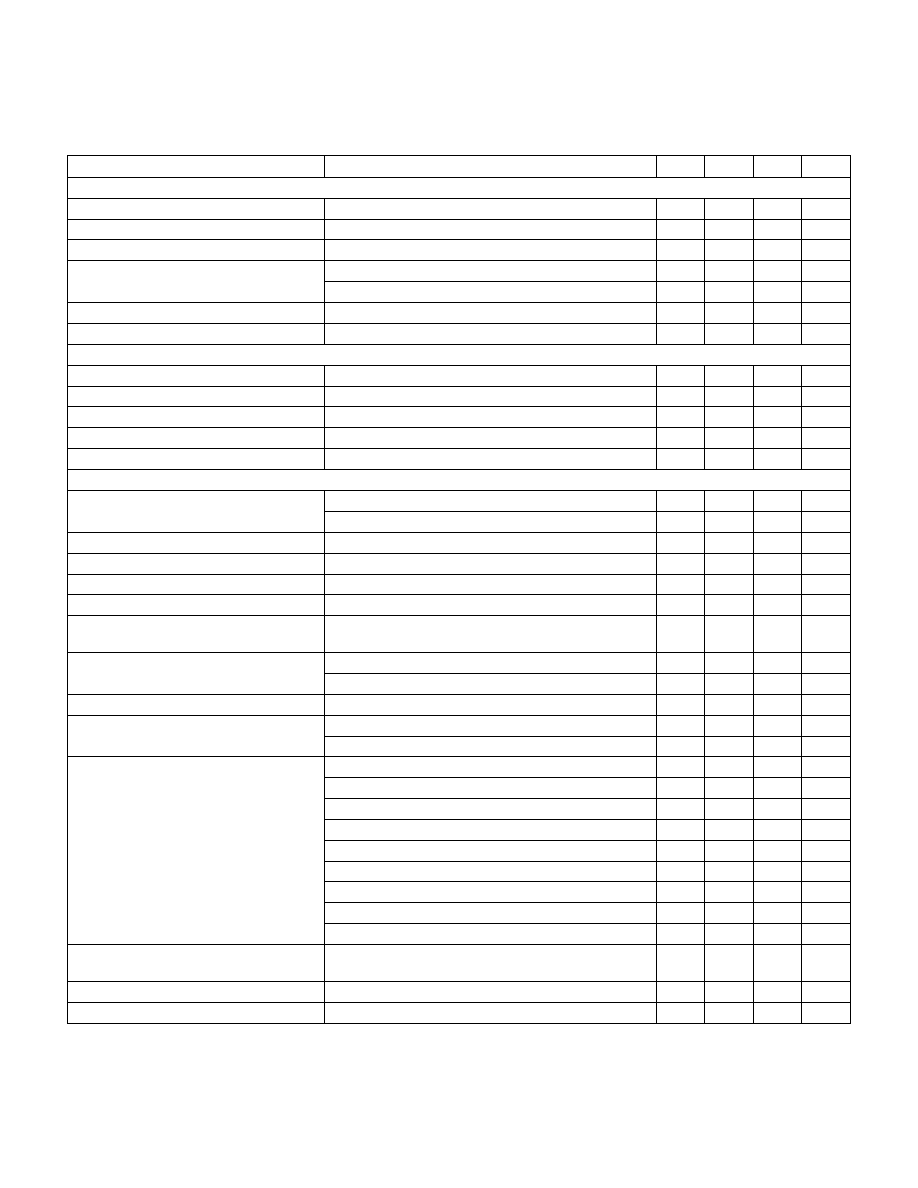
3
UC3173A
ELECTRICAL CHARACTERISTICS:
Unless otherwise stated, these specifications apply for T
A
= 0 to +70
į
C, VIN = 5V,
VC = VIN = VL, REFIN = VIN/2, RANGE, PARK, and INH = 0V, and T
A
=T
J
.
PARAMETER
TEST CONDITIONS
MIN
TYP
MAX
UNITS
Input Supply
VIN Supply Current
10
13
mA
VC Supply Current
I
OUT
= 0A
1.2
2.0
mA
VL Supply Current
0.65
1.0
mA
Total Supply Current
Supplies = 5V, I
OUT
= 0A
12
16
mA
Supplies = 12V, I
OUT
= 0A
13
18
mA
VL UVLO Threshold
Low to High
2.6
2.8
V
UVLO Threshold Hysteresis
300
mV
Under Voltage (UV) Comparator
Input Bias Current
Max at Either UV Input
-
0.25
-
1.0
Ķ
A
UV Thresholds
Low to High, Other Input = 5V
1.28
1.3
1.32
V
UV Threshold Hysteresis
19
24
29
mV
PWROK Vsat
I
OUT
= 5mA, UV Input Low
0.15
0.45
V
PWROK Leakage
V
OUT
= 20V
5
Ķ
A
Power Amplifiers A and B
Input Offset Voltage
A Amplifier, V
CM
= 2.5V
4
mV
B Amplifier, V
CM
= 2.5V
12
mV
Input Bias Current
V
CM
= 2.5V, Inverting Inputs Only
-
150
-
500
nA
Input Bias Current at Ref. Input
(REFIN
-
CS+)/48k
, T
J
= 25
į
C
15
21
27
Ķ
A/V
CMRR
V
CM
= 1V to 10V, Supplies = 12V
70
90
dB
PSRR
VIN = 4V to 15V, V
CM
= 1.5V
70
90
dB
Large Signal Voltage Gain
Supplies = 12V, V
OUT
= 1V, I
OUT
= 300mA to
V
OUT
= 11V, I
OUT
=
-
300mA
3.0
15.0
V/mV
Gain Bandwidth Product
A Amplifier (Note 4)
2.0
MHz
B Amplifier (Note 4)
1.0
MHz
Slew Rate
(Note 4)
1.0
V/
Ķ
s
High-Side Current Limit
Low Range Mode
0.6
0.8
A
High Range Mode
1.1
1.6
A
Output Saturation Voltage
High-Side, I
OUT
=
-
100mA (Note 5)
0.7
V
High-Side, I
OUT
=
-
300mA (Note 5)
0.8
V
High-Side, I
OUT
=
-
550mA (Note 5)
0.95
V
Low-Side, I
OUT
= 100mA
0.2
V
Low-Side, I
OUT
= 300mA
0.25
V
Low-Side, I
OUT
= 550mA
0.35
V
Total V
SAT
, I
OUT
= 100mA
0.9
1.2
V
Total V
SAT
, I
OUT
= 300mA
1.05
1.4
V
Total V
SAT
, I
OUT
= 550mA
1.3
1.7
V
VC to VIN Headroom
Volts below VIN, delta High-Side, V
SAT
= 100mV, I
OUT
=
-
550mA (Note 5)
0.23
0.4
V
High-Side Diode, V
F
I
D
= 550mA
1.0
V
Low-Side Diode, V
F
I
D
= 550mA, INH Activated, B Amplifer Only
1.0
V
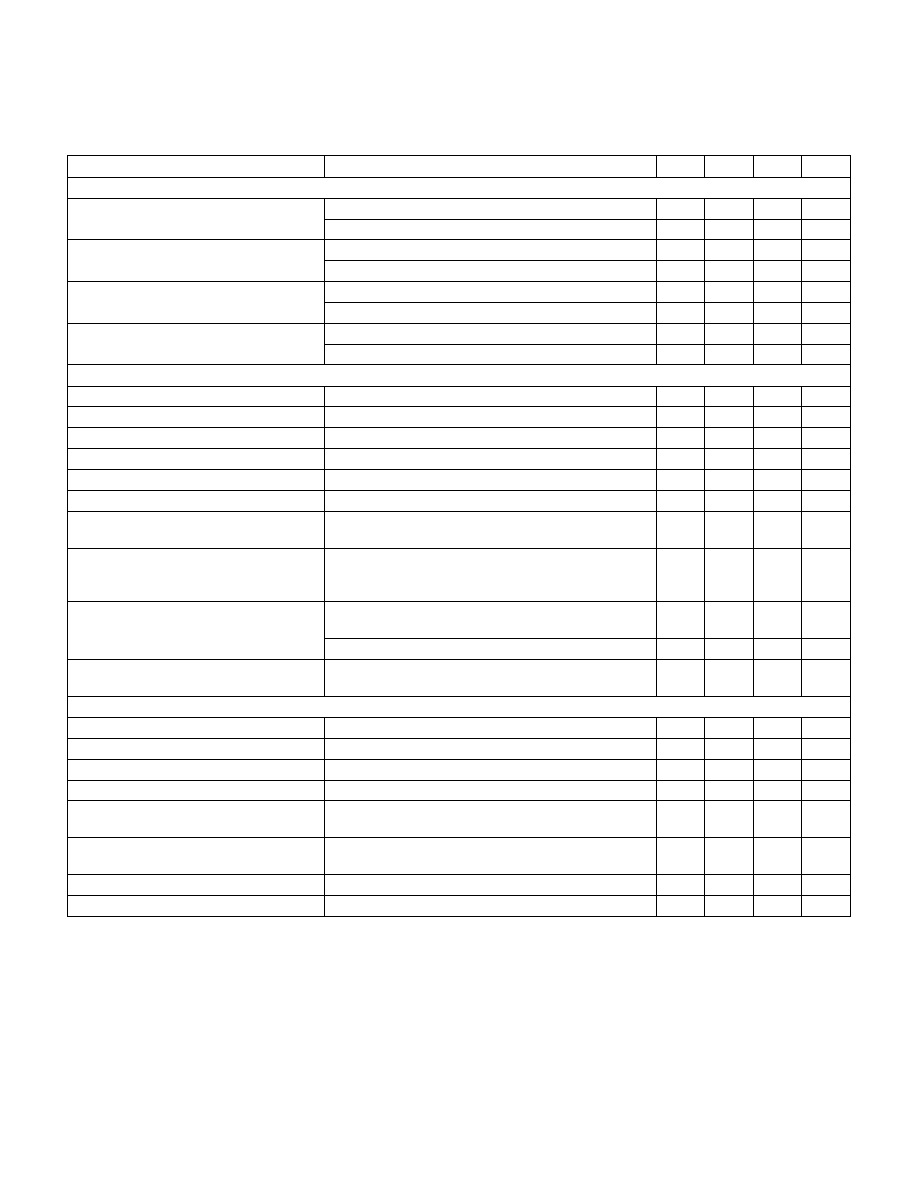
4
UC3173A
ELECTRICAL CHARACTERISTICS:
Unless otherwise stated, these specifications apply for T
A
= 0 to +70
į
C, VIN = 5V,
VC = VIN = VL, REFIN = VIN/2, RANGE, PARK, and INH = 0V, and T
A
=T
J
.
PARAMETER
TEST CONDITIONS
MIN
TYP
MAX
UNITS
Current Sense Amplifier
Input Offset Voltage
V
CM
= 2.5V, Low range mode
2.0
mV
V
CM
= 2.5V, High range mode
4.0
mV
Input Offset Change with Common
Mode Input
V
CM
= ≠1V to 13V, Supplies = 12V, Low Range Mode
2000
Ķ
V/V
V
CM
= ≠1V to 13V, Supplies = 12V, High Range Mode
4000
Ķ
V/V
Voltage Gain
V
DIFF
= +1.0 to
-
1.0V, V
CM
= 2.5V, High Range Mode
0.485
0.50
0.515
V/V
V
DIFF
= +1.0 to
-
1.0V, V
CM
= 2.5V, Low Range Mode
1.95
2.0
2.05
V/V
Saturation Voltage
Low-Side, I
OUT
= 1mA
0.1
0.3
V
High-Side, I
OUT
=
-
1mA, Referenced to VIN
0.1
0.3
V
Parking Function
Park Input Threshold Voltage
0.6
1.1
1.7
V
Park Input Threshold Current
Internal Pull-Up, VIN = 0.6V
50
75
Ķ
A
Park Drive Saturation Voltage
I
OUT
= 50mA
0.15
0.35
V
Park Drive Leakage
V
OUT
= 20V
50
Ķ
A
Regulating Voltage at Park Volts Input
1.275
1.30
1.325
V
Amplifier A Auxiliary Input Bias Current
-
300
-
750
nA
Amplifier A Parking High-Side
Saturation Voltage
I
OUT
=
-
50mA, VIN = 0V, VC = VL = 5V, PARK Open,
VC to V
OUT
0.8
0.95
V
Minimum Parking Supply
At VC and VL, VIN = 0V,
A Amplifier Out - V
SAT
PRKDRV > 0.5V, I
PARK
=
50mA
1.4
1.7
V
Minimum Supply for Parking Drive and
Power OK Operation
At VL, VC = VIN = 0V, V
SAT
< 0.5V,
I
OUT
PRKDRV = 50mA, Rl = 30
to 2V
1.1
1.4
V
I
OUT
PWROK = 5mA, Rl = 300
to 2V
1.2
1.6
V
VL Parking Supply Current
PARK Open, VL = 5V, VC = 1.6V, VIN = 0V,
PWROK I
OUT
= 5mA, PRKDRV I
OUT
= 50mA
1.6
3.0
mA
Auxiliary Functions
Inhibit Input Threshold
0.6
1.1
1.7
V
Inhibit Input Current
INH = 1.7V
-
0.5
-
1.0
Ķ
A
Range Input Threshold
0.6
1.1
1.7
V
Range Input Current
RANGE = 1.7V
50
100
Ķ
A
Comp Adjust Pin Saturation Voltage
RANGE = 0V, Pin Current =
Ī
500
Ķ
A,
Referenced to A
OUT
0.02
0.1
V
Comp Adjust Leakage Current
RANGE = 1.7V, Supplies = 12V,
A
OUT
- V
COMP
=
Ī
6V
5
Ķ
A
Total Supply Current when Inhibited
VIN, VC, and VL currents
1.0
1.5
mA
Thermal Shutdown Temperature
(Note 4)
165
į
C
Note 4: Guaranteed by design. Not 100% tested in production.
Note 5: The high-side saturation performance of the UC3173A is referenced to the VIN supply pin.
The VC supply pin can operate about 400mV below the VIN supply input without affecting the performance.

5
UC3173A
AIN: Inverting input to the A amplifier. Used as the sum-
ming node to close the loop on the overall power ampli-
fier.
AOUT: Output for the A power amplifier, providing one
end of the differential drive to the load during normal op-
eration and during park. During a UVLO condition at the
VIN supply pin, this output is forced to a high, source
only state. When the UC3173A is inhibited, this output
will be set high, in a source only state.
BIN: Inverting input to the B amplifier. Used to program
the gain of the B amplifier to guarantee maximum volt-
age swing to the load.
BOUT: Output for the B power amplifier, providing one
end of the differential drive to the load during normal op-
eration. During park and while inhibited this pin is
tristated.
COMP: The compensation adjust pin allows the user to
provide an auxiliary compensation network for the A am-
plifier that is only active when the current sense amplifier
is in the low range. With this option, the user can control
the change in bandwidth that would otherwise result
from the gain change in the feedback loop.
CS≠: The inverting input to the current sense amplifier is
typically tied to the load side of the series current sense
resistor. This pin can be pulled below ground during an
abrupt load current change with an inductive load.
Proper operation of the current sense amplifier will result
if this pin does not go below ground by an amount
greater than: REFIN / 2 ≠0.3V, in low range mode, and 2
∑
REFIN ≠0.9V, in high range mode.
CS+: The noninverting input to the current sense ampli-
fier is typically tied to the connection between the A am-
plifier output and the current sense resistor connected in
series with the load.
CSOUT: The output of the current sense amplifier has a
1.5mA current source pull-up and an active NPN
pull-down. The output will pull to within 0.3V of either rail
with a load current of less than 1mA.
GND: Reference point for the internal reference, UV
comparator, and other low level circuitry.
INH: A high impedence logic input that disables the A
and B power amplifiers, as well as the Current Sense
amplifier. The UV comparators and logic functions of the
UC3173A remain active. This input has an internal
pull-up that will inhibit the device if the input is left open.
The Inhibit function is overridden by any condition that
forces the Park function to be activated.
PARK: Input that forces the park condition on the
UC3173A. This input has an internal pull-up that will
force the park condition if the pin is left open.
PGND: Current return for all high level circuitry, this pin
should be connected to the same potential as GND.
PRKDRV: A 100mA drive output that is active low during
a park operation. This pin is normally used to supply the
lowside drive to the load during parking, in place of the B
amplifier. A series resistor can be added between this
pin and the load to limit current during park.
PWROK: Indicates with an active low condition that ei-
ther of the UV inputs are low, or that the supply voltage
at the VL input to the UC3173A has dropped below the
UVLO threshold. This output will remain active low until
the VL supply has dropped to below approximately 1.2V.
RANGE: When this pin is open or at a logic low poten-
tial, the current sense amplifier will be in its low range
mode. In this mode the voltage gain of the amplifier will
be 2. If this pin is brought to a logic high, the gain of the
current sense amplifier will change into its high range
value of 0.5. This factor of four change in gain will vary
the overall transconductance of the power amplifier by
the same ratio, with the transconductance being the
highest in the high mode. This feature allows improved
dynamic range of load current control for a given control
input range and resolution.
REFIN: Reference for input control signals to the power
amplifier, as well as, the noninverting inputs to the A and
B amplifiers, and the output level shift for the CS ampli-
fier.
VC: High current supply to the collectors of the high side
NPN output devices on the A and B amplifiers. This sup-
ply should be powered whenever the A or B amplifiers
are activated. This pin can operate approximately 400mV
below the VIN supply without affecting the voltage avail-
able to the load. This supply pin provides drive to the
power amplifiers during a parking operation.
VIN: Provides bias supply to both the power amplifiers
and the current sense amplifiers. The high-side drive to
the power stages on both the A and B amplifiers is refer-
enced to this pin. The high side saturation voltages are
specified and measured with respect to this supply pin.
The parking function of the device is fully operational in-
dependent of the voltage at this pin.
PIN DESCRIPTIONS
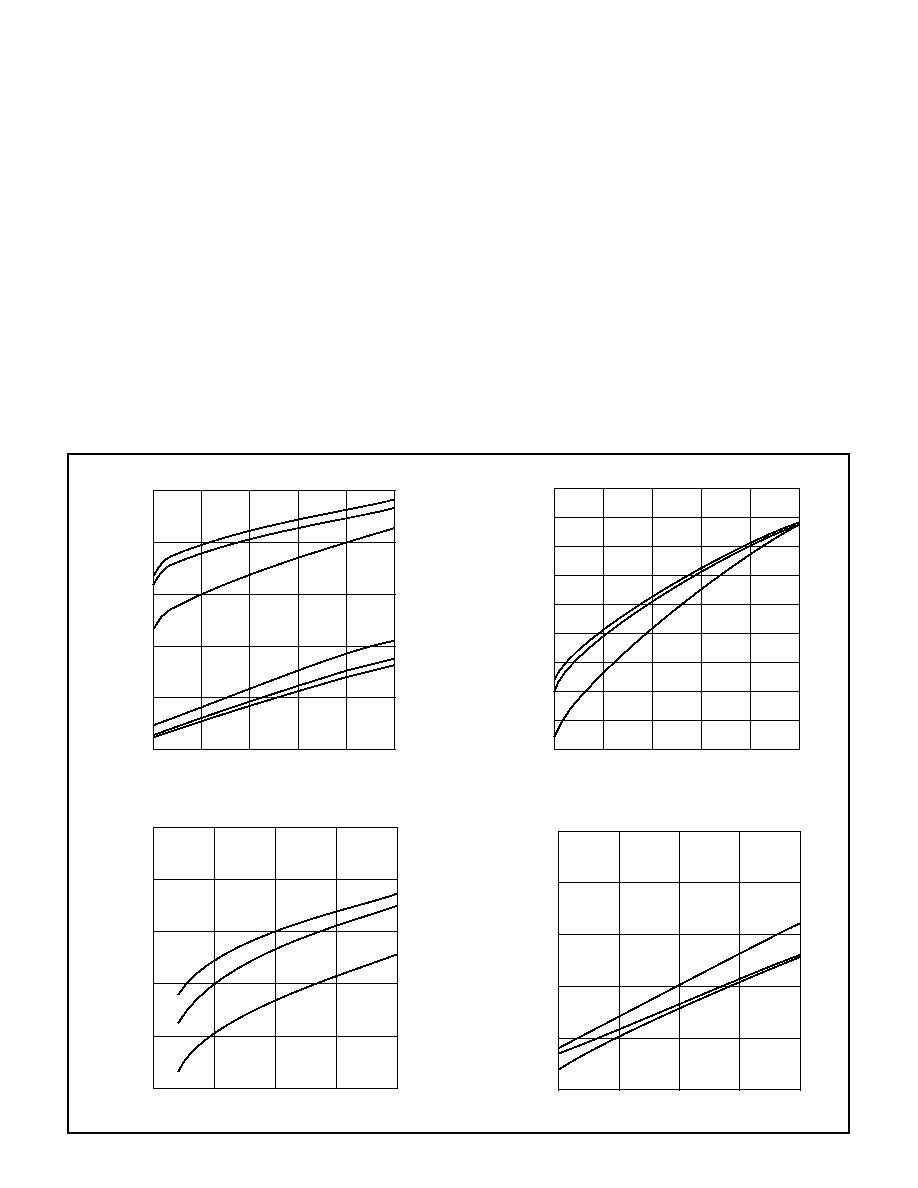
6
UC3173A
VL: Logic portions of the UC3173A are powered by this
supply pin, including the reference, UVLO, the UV com-
parators, and the PRKDRV and PWROK outputs. This
pin is a low current supply that would normally be tied to
the VC pin, or to a parking hold up capacitor for ex-
tended parking operation with very low recovered back
emf.
VPARK: The auxiliary inverting input to the A amplifier,
activated during park conditions on the UC3173A. An in-
ternal auxiliary non-inverting input is connected to the
1.3V reference. When the auxiliary inputs are activated,
the A amplifier will force a programmed voltage at its out-
put for a maximum back-emf/velocity retract of the head.
The park condition on the UC3173A is always activated
by any one of the following four conditions, 1: a low con-
dition on either of the UV inputs, 2: a high input level at
the Park input, 3: a UVLO condition at the VL supply pin,
and 4: activation of the TSD, (thermal shutdown) protec-
tion circuit. During a UVLO condition at the VL pin the
auxiliary inputs to the A amplifier are over-ridden, and
the A amplifier output is forced to its high state.
UV1 & 2: Inputs to the UV comparator, these inputs are
high impedance sensing points used to monitor external
supply conditions. Either of the inputs going low will force
the device into a park condition, and force the PWROK
output to an active low state. If either of these inputs is
not used it should be connected to a voltage greater
than 1.3V.
PIN DESCRIPTIONS (cont.)
0
0.2
0
100
200
300
400
500
0.4
0.6
0.8
1
0įC
0įC
25įC
25įC
125įC
125įC
LOW-SIDE
HIGH-SIDE
Output Current (mA)
V(
V
o
l
t
s
)
SA
T
A and B Amplifier High and Low V
SATS
0.5
0.6
0.7
0.8
0.9
1.0
1.1
1.2
1.3
1.4
0
100
200
300
400
500
0įC
25įC
125įC
Output Current (mA)
T
o
ta
l
V
(V
o
l
ts
)
SA
T
A and B Amplifier Total V
SAT
0
0.2
0
50
100
150
200
0.4
0.6
0.8
1
0įC
25įC
125įC
A or B Amplifier High-Side V
Increase (mVolts)
SAT
VI
N
-
VC
(
V
ol
t
s
)
I
=
450mA
OUT
VIN to VC Headroom
0
0.1
0
5
10
15
20
0.2
0.3
0.4
0.5
0įC
25įC
125įC
Power OK Output Current (mA)
Po
w
e
r
O
K
V
(
V
o
l
t
s
)
SA
T
PWROK Saturation Voltage
APPLICATION INFORMATION

7
UC3173A
APPLICATION INFORMATION (cont.)
0.4
0.5
0.6
0.7
0.8
0.9
1.0
1.1
1.2
0
100
200
300
0įC
25įC
125įC
Output Current (mA)
A
A
mp
Hi
gh-
Si
de
SA
T
(
VC
t
o
A
O
UT)
(
V
o
l
t
s)
VIN = 0V
VC = VL = 2V
A Amplifier High-Side V
in Park Mode
SAT
0
0.1
0.2
0.3
0.4
0.5
0.6
0.7
0
10
100
150
0įC
25įC
125įC
Output Current (mA)
P
a
rk
i
n
g
D
ri
v
e
V
(
V
o
l
t
s
)
SA
T
PRKDRV Saturation Voltage

UC3173A
8
Figure 1. Typical application.
APPLICATION INFORMATION (cont.)
Design Procedure for Application of the UC3173A
The following is a simple design flow that can be used to
configure the UC3173A Full Bridge Power Amplifiers as
shown in Fig. 1.
A. Current Sense Resistor
Choose R
S
to be as large as head room will tolerate, this
is the series current sense resistor.
B. Select Feedback Resistance
Choose a value of R
FB
to be less than the peak current
sense amplifier swing divided by 1mA. A value in the
range of 3k to 10k is suggested.
C. Set Transconductance
Calculate R
FA
according to:
R
=
R
0.5 R
G
FA
FB
S
mHR
∑
∑
(1)
If the range change option is not going to be used, it is
recommended that the device be set in the low range
mode and R
FA
be calculated by:
R
=
R
2 R
G
FA
FB
S
mLR
∑
∑
(2)
D. Optimize Voltage Swing
In order to assure that maximum voltage drive to the
load is achievable, there are some precautions that
should be taken. In a standard configuration, the B am-
plifier is slaved to the A amplifier. The bias point of the
and the gain of the B amplifier, as well as the saturation
voltages of the power output stages, will affect the volt-
age available to the load.
There are two simple procedures to follow, either will
insure that the capabilities of the device are fully utilized.
The first is to set the REFIN voltage at the center of the
available voltage swing at the output of the power
amplifiers. This optimum reference is defined by
equation (3)
GM =
IL
V
=
R
R
I
AV
R
S
FB
FA
CS
S
∑
∑
AV
CS
=Current Sense Amplifier Gain = 2.0 Low Range, 0.5 High Range
f
3DB
= the closed loop 3dB bandwidth
A
V
B
= B amplifier closed loop gain, = R6/R5
A
V
CS
= current sense amplifier gain, = 0.5 in high range,
and 2.0 in low range
f
GBW
A
= gain bandwidth product of the A amplifier
G
mHR
= closed loop transconductance in high rangemode
G
mLR
= closed loop transconductance in low range mode
L
= load inductance
R
L
= load resistance
Definitions:
UDG-94040

9
UC3173A
(
)
(
)
V
(optimum) =
VIN - V
+ V
2
REFIN
HS SAT
LS SAT
(3)
Where:V
HS(SAT)
= high-side V
SAT
at maximum load
V
LS(SAT)
= low-side V
SAT
at maximum load.
A second approach is to raise the gain of the B amplifier
to insure maximum swing. For a given REFIN voltage the
gain of the B amplifier, set by the ratio of the feedback
resistors, can be made greater than unity as given by:
(
)
(
)
A B =
VIN ≠ V
≠ V
V
≠ V
V
HS SAT
REF
REFIN
LS SAT
or,
(4)
(
)
(
)
V
≠ V
VIN ≠ V
≠ V
REFIN
LS SAT
HS SAT
REF
whichever is greater than unity.
For a typical case, where V
REFIN
has been set at VIN/2,
the required gain for a 5 volt system will be about 1.5,
and for a 12 volt system, 1.2.
It is worth noting that when using this method the B am-
plifier will saturate before the A amplifier on one polarity
of the voltage swing. During the time when the B ampli-
fier is saturated and the A amplifier is not, the small sig-
nal bandwidth of the loop will be reduced by a factor of
(A
V
B + 1).
E. Loop Compensation
The normal configuration for compensation of the power
amplifier is shown in Fig. 1. A simple R
C
network, R
C
C
C
,
around the A amplifier is all that is required. The value of
the R
C
C
C
time constant is typically chosen to correspond
to the electrical time constant of the load, given by R
L
/L.
The bandwidth of the closed loop amplifier can be set by
choosing the value of R
C
. Calculate R
C
according to:
R
=
2 L f
R
(1 + A B)A CS R
C
3dB
FB
V
V
S
∑
∑
∑
(5)
Use A
V
CS = 0.5 if range changing is to be used, and
A
V
CS = 2.0 if only the low range mode of operation is to
be used.
The compensation zero is typically set to coincide with
the L/R time constant of the Load. C
C
can then be calcu-
lated by:
C
=
L
R (R
+ R )
C
C
S
L
(6)
In the closed loop transconductance amplifier, the A am-
plifier operates at the highest noise gain. Noise gain is a
measure of the feedback ratio at which the amplifier is
operating. For the configuration of the A amplifier in Fig.
1, the noise gain is given by the impedance ratio of the
R
C
-C
C
series network, to the parallel combination of R
FA
and R
FB
. For the A amplifier to operate at its expected
closed loop gain, the noise gain at any frequency must
not exceed its Gain Bandwidth Product (GBW) divided
by that frequency. Applying this to the expression above
will yield a result for the maximum 3dB bandwidth that
can be achieved for a given configuration.
(
)
f
=
f
A (1 + A B) A CS R
R
2 L (R
+ R
)
3dB MAX
GBW
V
V
S
FA
FA
FB
∑
∑
∑
∑
∑
1
2
(7)
Where: f
GBW
A is the GBW of the A amplifier.
In the UC3173A, to accommodate wider power amplifier
bandwidths, the GBW Product of the A amplifier has
been extended to 2MHz. Care should be taken that the
A amplifier gain bandwidth product is not limiting the
closed loop performance of the configured power ampli-
fier. This is easily checked by making sure that R
C
is
less than a critical value, R
C(MAX)
, as given by:
R
= R
f
A 2 L R
(A B + 1) A CS R (R
+ R
)
C(MAX)
FB
GBW
FA
V
V
S
FA
FB
∑
∑
∑
∑
1
2
(8)
Again, use A
V
CS = 0.5 if range changing is used, and
A
V
CS = 2.0 if only the low range mode of operation is
used.
F. Using The Comp Pin
When the range change feature of the UC3173A is
used, the closed loop bandwidth of the power amplifier
will change according to (7). In other words, the band-
width would be four times larger during the low range
mode when A
V
CS is equal to 2, than during the high
range mode when A
V
CS is equal to 0.5, unless the
value of R
C
is adjusted to compensate.
The COMP pin on the UC3173A can be used to do this.
The COMP pin acts as a simple switch that allows a par-
allel compensation network to be applied around the A
amplifier during low range operation. A simple network
as shown here will keep the loop response constant in-
dependent of the range condition.
To maintain the same 3dB bandwidth in both the high
and low range modes set R
CA
and C
CA
to:
R
=
R
3
, C
= 3C
CA
C
CA
C
(9)
APPLICATION INFORMATION (cont.)

10
UC3173A
Head Parking
In Fig. 2, the UC3173A is shown configured to force a
programmed voltage at the A amplifier output upon the
activation of a park condition. A pair of feedback resistors
R1 and R2 set this voltage as defined by:
R1 = R2
VPARK
1.3
≠ 1
(10)
R2 is typically chosen in the range of 10k
to 100k
.
The B amplifier output is tri-stated during park, this side
of the load is driven low by the PRKDRV pin. A series re-
sistor, RP in the figure, can be inserted in series with the
load to limit the peak current if required.
The UV thresholds for the supply monitors are set by
picking R4 and R6 values in the 10k
to 100k
range
and then calculating R3 and R5 according to:
R3 = R4
UV1
1.3
≠ 1 , and R5 = R6
UV2
1.3
≠ 1
(11)
During park, supply to the load, and the UC3173A, is
typically recovered from the back EMF of the spindle
motor. When the supply voltage at the VL supply pin
drops below the UVLO voltage, (2.3V high-to-low), the
output of the A amplifier is forced high, over-riding the
programmed park voltage. The UC3173A will maintain
drive to the load down to low supply levels. For example,
with 1.5 volts of recovered back EMF, the UC3173A can
still deliver 50mA of drive to a 10
load.
Parking With Very Low Back EMF
The UC3173A can also be configured to get parking
drive to the load with very low recovered back EMF. Fig.
3 illustrates how the PWROK pin can be used to drive
an external PNP device to achieve very low parking
drive V
SAT
losses. With this configuration, the UC3173A
will be able to force approximately one volt across the
load with a recovered back EMF voltage of 1.3V.
During system commanded parking with the supplies
present, the VPARK pin is still used to set the maximum
voltage to the load. The logic function of the PWROK pin
is still available since the external PNP will provide isola-
tion to this output when it is high.
Base drive to the PRKDRV and PWROK pins are pro-
vided by the VL supply pin. By using a hold up capacitor,
C
HOLD
, the drive can be maintained to the load as the
back EMF drops to below 1V. A variation on this ap-
proach is to add a connection between the VL pin and
the recovered back EMF, this will eliminate the need for
the holdup capacitor and provide operation down to
about 1.2V of back EMF recovery. Care with this ap-
proach should be taken in case the 5V supply hangs at
just below the programmed UV threshold. In this situa-
tion large currents could flow from this supply through
the external PNP and into the A output which, until the
supply drops below a certain level, is forcing a pro-
grammed voltage.
APPLICATION INFORMATION (cont.)
The COMP pin switches in a parallel compensation
network to stabilize the small signal bandwidth with
range changes.
UDG-94041
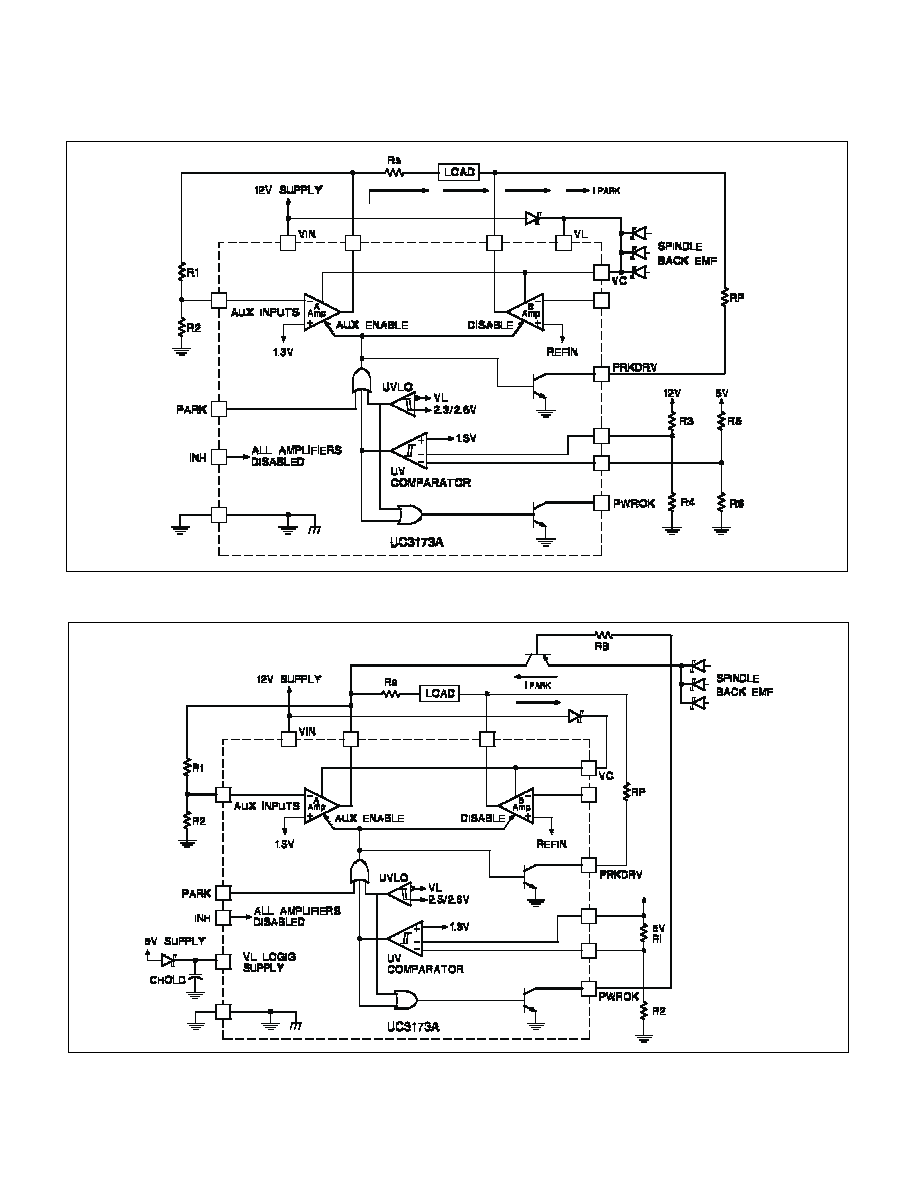
11
UC3173A
UNITRODE CORPORATION
7 CONTINENTAL BLVD. ∑ MERRIMACK, NH 03054
TEL. (603) 424-2410 ∑ FAX (603) 424-3460
Figure 3. Head parking with low back EMF.
UDG-94043
Figure 2. Controlled velocity head parking.
UDG-94042

IMPORTANT NOTICE
Texas Instruments and its subsidiaries (TI) reserve the right to make changes to their products or to discontinue
any product or service without notice, and advise customers to obtain the latest version of relevant information
to verify, before placing orders, that information being relied on is current and complete. All products are sold
subject to the terms and conditions of sale supplied at the time of order acknowledgement, including those
pertaining to warranty, patent infringement, and limitation of liability.
TI warrants performance of its semiconductor products to the specifications applicable at the time of sale in
accordance with TI's standard warranty. Testing and other quality control techniques are utilized to the extent
TI deems necessary to support this warranty. Specific testing of all parameters of each device is not necessarily
performed, except those mandated by government requirements.
CERTAIN APPLICATIONS USING SEMICONDUCTOR PRODUCTS MAY INVOLVE POTENTIAL RISKS OF
DEATH, PERSONAL INJURY, OR SEVERE PROPERTY OR ENVIRONMENTAL DAMAGE ("CRITICAL
APPLICATIONS"). TI SEMICONDUCTOR PRODUCTS ARE NOT DESIGNED, AUTHORIZED, OR
WARRANTED TO BE SUITABLE FOR USE IN LIFE-SUPPORT DEVICES OR SYSTEMS OR OTHER
CRITICAL APPLICATIONS. INCLUSION OF TI PRODUCTS IN SUCH APPLICATIONS IS UNDERSTOOD TO
BE FULLY AT THE CUSTOMER'S RISK.
In order to minimize risks associated with the customer's applications, adequate design and operating
safeguards must be provided by the customer to minimize inherent or procedural hazards.
TI assumes no liability for applications assistance or customer product design. TI does not warrant or represent
that any license, either express or implied, is granted under any patent right, copyright, mask work right, or other
intellectual property right of TI covering or relating to any combination, machine, or process in which such
semiconductor products or services might be or are used. TI's publication of information regarding any third
party's products or services does not constitute TI's approval, warranty or endorsement thereof.
Copyright
©
1999, Texas Instruments Incorporated











